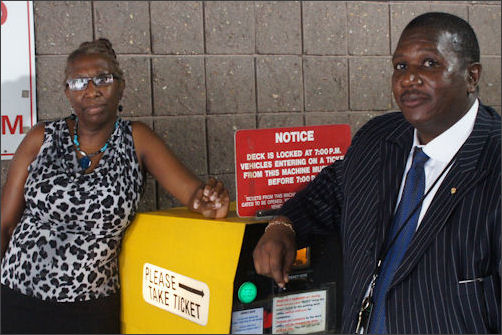City Hall is trying to bring order and reason to the administration of downtown Richmond’s 24,000 parking spaces. The job could take years.
by James A. Bacon
To get an idea of just how crazy the parking problem was in downtown Richmond before City Hall decided to give focused attention to the situation, consider this. In the 23-block Capitol District, dominated by city, state and federal office buildings, there was more than enough parking to handle the demand — nearly 1,800 spaces between on-street, surface and structured parking — and only two thirds of it was occupied, according to a 2009 parking study. Yet government employees were hogging the on-street spaces, making it difficult for citizens transacting business with the city to find a space to park.
“People were working all day long and monopolizing on-street parking spaces” said Lynne Lancaster, operations manager for the Richmond Department of Public Works, who oversees parking. “Many people were feeding the meter, running in and out of the office all day long.”
Some didn’t even bother feeding the meter. They learned that if they got tickets, nothing would happen. No one collected the fines. One individual racked up 1,400 tickets. “He was basically daring the city to do something,” declared James Jackson, director of public works.
I was meeting with the city’s two parking czars in a coffee shop just around the corner from a Richmond Metropolitan Authority (RMA) parking deck that the city was planning to take over (and since has) in order to rationalize the fractured ownership and operation of public parking assets. Earlier, City Council had raised rates on metered parking. On the theory that parking policy was one of the most under-rated and under-appreciated functions of municipal government, I’d set up the tete-a-tete to find out what the city administration was up to.
For years, parking policy had been conducted on an ad hoc basis. If merchants or other downtown constituencies wailed loudly enough, the city or some quasi-independent authority would build a new parking deck. At various points in time, the city also tried installing more parking meters for on-street parking, un-installing meters, relaxing enforcement of violations, and then ratcheting it back up. There seemed to be no underlying vision guiding the city’s actions.
A parking strategy began to cohere in 2002 with a seminal parking study, and then came into sharp focus in 2009 with a follow-up report by Timothy Haahs & Associates, a Miami, Fla., consulting firm. Those studies sketched out a vision for how parking could contribute to creating “a vibrant downtown containing active streets, pedestrian life, and occupied storefronts.” Among other critical findings, the Haahs report debunked the perception that “there are not enough downtown parking spaces.” While there were localized shortages in certain districts, downtown Richmond in 2009 had 24,019 spaces and peak demand of 17,000 — a surplus of roughly 7,000 spaces.
Further, the report found, spot shortages of on-street parking could be remedied by raising rates. It is an axiom of municipal parking policy that rates should rise to the point where on-street spaces are 85% occupied. That level ensures that spaces are nearly fully utilized but have enough vacancies that people can readily find somewhere to park without contributing to congestion by driving around and looking for a space. Proper pricing for street parking also encourages drivers to utilize structured parking, of which there is an abundance downtown.
Of the 22 recommendations advanced in the two parking studies, the city has implemented about half, says Jackson. One accomplishment has been to bump up the hourly rates from $.50 to $.75 — higher than before, but still short of a market rate. “[Mayor Dwight Jones] appreciated that the recommendation was to raise the rates. But he said to raise them incrementally. He didn’t want to give anyone sticker shock.” The idea, says the public works chief, is “to wade in, as opposed to jump in.”
Another priority was consolidating ownership and control of the public parking facilities. Entities holding a stake in public parking assets included the RMA, the Richmond Housing Authority, the Broad Street Community Development Authority, the Economic Development Authority and the city itself. The city could save considerable money by spreading the management and operation of its parking facilities over a larger number of parking structures. Stated the report:
The numerous entities controlling these assets create a bureaucratic nightmare in which no single person or group is the ‘go-to person.’ From a management standpoint this is not the most efficient system to manage parking. We believe it is imperative for the City to take the proper steps towards developing a centralized parking operation in which all the assets are controlled and managed by one agency.
One critical step was taking over the RMA parking deck built in the air rights above the Downtown Expressway. The city financed construction of the structure in 1990 by purchasing $18.9 million in bonds issued by the RMA. The plan was for the RMA to pay off the bonds from profits generated by the deck. But revenues fell woefully short. Twenty years later, the RMA owed the city the entire principal amount plus $15 million in unpaid interest. The city administration proposed taking over the parking deck and forgiving the $33 million — an idea that did not go over well with some council members, who said the RMA has plenty of money and should pay the city back. In the end, Council approved the transaction. Read more.
